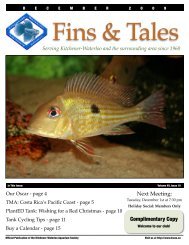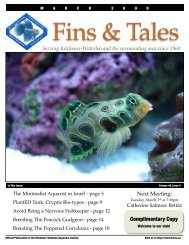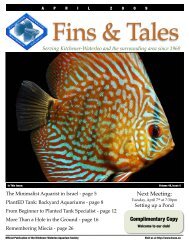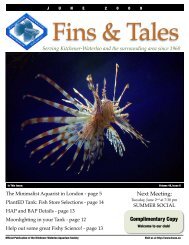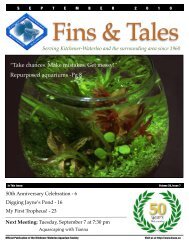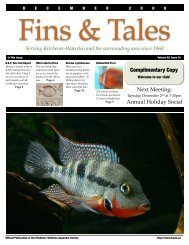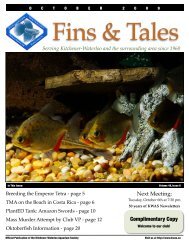June 2007 - Kitchener Waterloo Aquarium Society
June 2007 - Kitchener Waterloo Aquarium Society
June 2007 - Kitchener Waterloo Aquarium Society
You also want an ePaper? Increase the reach of your titles
YUMPU automatically turns print PDFs into web optimized ePapers that Google loves.
fins & tales <strong>June</strong> <strong>2007</strong><br />
Exchange Editor’s <strong>June</strong> Report<br />
by Zenin Skomorowski KWAS<br />
zenin@golden.net<br />
The newsletters featured in this column<br />
and others are available to you.<br />
Please let me know by email, or at the<br />
monthly meeting, which ones you<br />
would like to read.<br />
A couple of months ago, Charlie Drew<br />
from the Hamilton & District <strong>Aquarium</strong><br />
<strong>Society</strong> came to talk to KWAS<br />
about plecos. Read his article on<br />
“Spawning the King Tiger Pleco” in<br />
the April issue of The Monthly Bulletin.<br />
This carnivore, also known as L-<br />
066, grows to about 12cm (5 inches)<br />
and is grey with black striped markings.<br />
Rick Wittner writes about Neolamprologus<br />
leleupi in the April issue of<br />
TropiQuarium from the Motor City<br />
<strong>Aquarium</strong> <strong>Society</strong>. Sometimes known<br />
as firecrackers, these rock-loving cichlids<br />
from Lake Tanganyika, make a<br />
great addition to your rift lake setup.<br />
Do scientific names of fish give you<br />
grief ? Paul Mansfield writes about<br />
their importance and gives some tips<br />
on pronunciation in the April issue of<br />
Fins & Friends from the Regina<br />
<strong>Aquarium</strong> <strong>Society</strong>.<br />
Wayne Cole describes his experience<br />
“Breeding Labidochromis Pearlmutt”<br />
in the April issue of Aqua Antics from<br />
The Sarnia <strong>Aquarium</strong> <strong>Society</strong>. This<br />
beautiful Malawi cichlid is quite<br />
peaceful and has a pearly white body<br />
with subtle dark bars and yellow dorsal<br />
and tail. Also in this issue, Wayne<br />
writes about his thoughts on the internet<br />
and <strong>Aquarium</strong>s clubs in “Will The<br />
Internet Spell Death for <strong>Aquarium</strong><br />
Clubs ?”.<br />
Part Two of “Working With Yabbies”<br />
by Tom Mason is in the April issue of<br />
Tank Talk from the Durham Region<br />
<strong>Aquarium</strong> <strong>Society</strong>. This is a<br />
continuation of his discussion of<br />
crayfish from Australia and their<br />
related cousins in Europe and<br />
North America. Derek P.S. Tustin<br />
talks about “Why I DIY or<br />
There Are Many Ways To Save<br />
A Buck”. Check out some of his<br />
suggestions for alternatives to<br />
supposedly “ aquarium specific”<br />
items.<br />
If you would like to keep an unusual<br />
killifish, then look for<br />
Pachypanchax sakaramyi. It is<br />
originally from northern Madagascar.<br />
Peter Melady relates his<br />
experience keeping this fish in<br />
the May issue of Aqua Antics<br />
from the Sarnia <strong>Aquarium</strong> <strong>Society</strong>.<br />
Also in this issue, Wayne<br />
Cole writes about “Breeding<br />
Copadichromis Borleyi”. This<br />
mouth brooder from Lake Malawi<br />
features males with blue<br />
faces and fins, a yellow body<br />
with orangey-red flash on the<br />
sides. The female has more subdued<br />
dark sides with red fins.<br />
Also in this issue, a very versatile<br />
plant is the “Indian Fern AKA<br />
Watersprite”. Marc Frey describes<br />
how this plant can be put<br />
into a clay pot with small gravel,<br />
or secured to glass with a suction<br />
cup, or left floating.<br />
Surf’s up ! Here is this<br />
month’s web sites to explore:<br />
Hans Brost, from Palm Springs<br />
California, decided to build an<br />
outdoor acrylic tank. I guess<br />
here in Canada, we would have<br />
to drain it and blow out the lines<br />
each fall, and refill in the spring,<br />
just like a swimming pool. The<br />
final size of his aquarium is<br />
about 500 gallons. He used his<br />
existing 50 gallon tank as the<br />
biological filter. There is also an<br />
underground thermal mass for<br />
heating and cooling, because<br />
some nights do get cool and daytime<br />
temperatures can be quite<br />
h i g h . h t t p : / /<br />
w w w . w i z a r d s c a v e . c o m /<br />
aquarium.html<br />
<strong>Kitchener</strong>-<strong>Waterloo</strong> <strong>Aquarium</strong> <strong>Society</strong><br />
23





